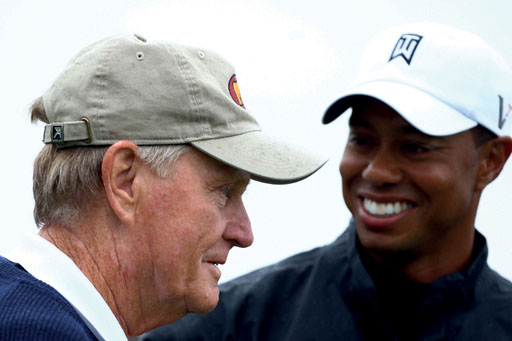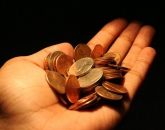 Golf has always been a ‘bull market sport’ in that it has always tended to flourish during periods of optimism and enthusiasm. To an extent this can be seen when the growth in money winnings by top professionals is compared to the appreciation in stock markets. In 1967, Jack Nicklaus was the world’s leading money winner. Had he taken his entire earnings that year and invested it all in the world stock market over the next 33 years it would have grown about 40 times in value. Coincidentally, Tiger Woods in 2000 won almost exactly 40 times what Jack had won in 1967. Not only has the overall growth been similar but the general ebb and flow along the way has also been shared. Again, this appears to be peculiar to professional golf. This relationship between investment markets and golf can be seen in both Jack and Tiger’s careers.
Golf has always been a ‘bull market sport’ in that it has always tended to flourish during periods of optimism and enthusiasm. To an extent this can be seen when the growth in money winnings by top professionals is compared to the appreciation in stock markets. In 1967, Jack Nicklaus was the world’s leading money winner. Had he taken his entire earnings that year and invested it all in the world stock market over the next 33 years it would have grown about 40 times in value. Coincidentally, Tiger Woods in 2000 won almost exactly 40 times what Jack had won in 1967. Not only has the overall growth been similar but the general ebb and flow along the way has also been shared. Again, this appears to be peculiar to professional golf. This relationship between investment markets and golf can be seen in both Jack and Tiger’s careers.
Both players arrived on the professional scene in the latter years of a long term bull market in equities. Tiger’s first full year as a professional saw him win his first major, the 1997 Masters, just as Jack won his first major, the 1962 US Open, in his debut season. By the time these long term bull markets ended – in 2000 for Tiger and 1966 for Jack – both had become firmly established as the ‘best player in the world’ and both had secured their first Grand Slams, although 1998 saw a hiatus for both Tiger and the markets. Tiger won no majors that year and slipped to fourth on the money list, while US markets suffered a substantial setback when hedge fund giant Long Term Capital Management collapsed. This all changed in 1999 and 2000 when, with equity markets racing higher, Tiger won four more majors and set successive money winning records.
From the 1966 peak the US stock market meandered in a wide trading range over the next 16 years, and incredibly Jack’s form seemed to mirror what was happening in the market.
He won the 1967 US Open but then began his longest major drought. This was broken with victory over Doug Sanders at the 1970 Open Championship, which amazingly coincided with the start of a new bull market just weeks earlier after a miserable 35 per cent decline in the US market. Throughout the seventies Jack’s major record echoed that of the markets, with 1974 being one of his worst years as a professional and the worst year for the market in decades.
Just as Jack’s career echoed the rise and fall of the markets from 1966 to 1974, the same was true for Tiger from 2000 through to 2008.
The year 2000 was Tiger’s career high point for the next five years and 2000 was also the high point for the Dow for the next six years. Through 2001 and 2002 Tiger continued to dominate but his earnings on the course were down substantially from his 2000 peak, so too were the world's share markets. From their 2003 lows share markets recovered and by 2005 and 2006 markets were at or approaching their old highs. So too was Tiger. He won two majors in each of those years and led the money winning stats, accumulating around US$10 million in both seasons. This continued into 2007 when he set his all time money winning peak with almost US$11 million. World markets also peaked in late 2007, prior to their most severe decline in seven decades.
2008 was a miserable year for investors and it was a huge disappointment for Tiger as he was forced to withdrew from competitive golf for knee surgery after winning the US Open in June. Tiger’s absence was painful for golf; TV ratings and crowds fell and at the same time the worst effects of the Global Financial Crisis were being felt.
 Tiger’s absence from golf may have been a blow to sponsors and fans but it turned out to be only a minor distraction compared to the turmoil that was being suffered in global financial markets. That turmoil was potentially going to have an even greater effect upon professional golfers and their tours than Tiger's non-appearance.
Tiger’s absence from golf may have been a blow to sponsors and fans but it turned out to be only a minor distraction compared to the turmoil that was being suffered in global financial markets. That turmoil was potentially going to have an even greater effect upon professional golfers and their tours than Tiger's non-appearance.
When Tiger returned to competitive golf in early 2009 the Dow Jones Industrial Average was down 40 per cent from where it had been when he secured his 14th major the previous year.
The prevalent mood was incredibly bleak. Amazingly, the stock market collapse only lasted another week after his return but at its low point in the second week of March the Dow was down 55 per cent from where it had been in October of 2007. It had been a horrendous 17 months for investors.
From that incredibly depressed level markets the world over rocketed higher, much to the surprise and disbelief of investors. Less than three weeks later Tiger teed up in the Arnold Palmer Invitational after the Dow had enjoyed one of its best rallies ever, surging 24 per cent. Tiger returned to form too, spectacularly winning the title for his 66th tour victory.
After the win at Bay Hill the rest of the year was almost vintage Tiger. He won five more times on tour, won the season-long FedEx Cup, won the money title and was voted the PGA Tour Player of the Year for the 10th time. The markets also enjoyed the balance of 2009. The Dow ended the year 60 per cent higher than it had been at the depths of the March lows.
With a win in Australia in November it seemed that 2010 was set fair for Tiger and the pursuit of his 15th major and his ultimate target of Jack’s record would continue. The recovery in markets had also raised expectations that Great Depression II had been averted and that things were back to normal for investors. Neither quite transpired as expected but the meltdown in Tiger’s personal and professional life was almost incomprehensible.
Whilst US markets delivered only a modest 10 per cent return in 2010, the year will go down in the record books as Tiger’s poorest ever as a professional. For the first time in his career he failed to win a single tournament. Tiger’s slump in form continued through 2011, a year that again saw the US markets deliver only a very modest six per cent return and again Tiger was winless. What had seemed his destiny just a couple of years earlier, to surpass eighteen majors, was beginning to look increasingly like a fragile dream.
By the end of 1977 Jack had been a professional for 16 seasons. In that time he had won 64 tour events including 14 majors. For the first four years of his professional career Jack enjoyed the tail wind of the crescendo of a bull market, but for the next 12 the investment environment became substantially more challenging as the market swung violently in a series of deep bear markets and strong but short recoveries.
As 2011 ended, Tiger had encountered almost the identical market back drop. His first four years saw the culmination of an incredible bull market and then the next dozen saw the market fall and rise in an even more violent fashion than during Jack’s career. Tiger had also won 14 majors and had won 71 tour events.
These parallels between both players and each player and the markets are remarkable, but only time will tell whether Tiger does ultimately achieve his long stated goal of winning more than 18 majors. It is worth remembering that it took Jack another nine seasons to win his final major, the 1986 Masters, and by the time he did the frustrating and volatile sideways tracking bear market that began in 1966 had ended and a remarkable new bull market had begun.

Kevin Armstrong is chief investment officer for ANZ. This article is a synopsis of a chapter from Bulls, Birdies, Bogeys and Bears to be published later this year by Wilkinson Publishing Pty Ltd
Click here to see the published article.











